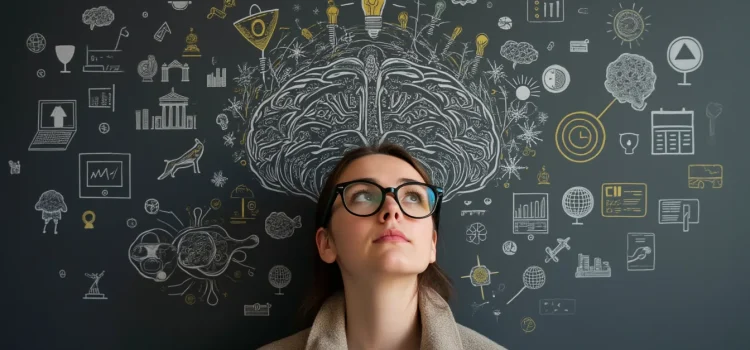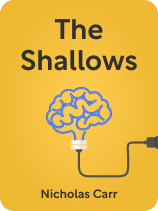

This article is an excerpt from the Shortform book guide to "The Shallows" by Nicholas Carr. Shortform has the world's best summaries and analyses of books you should be reading.
Like this article? Sign up for a free trial here.
Is technology reshaping our cognitive landscape? How might our digital habits be altering the way we think and process information?
The evolution of technology has profoundly impacted our brains. From maps and clocks to the internet, each new tool shapes our perception and mental processes. In The Shallows, Nicholas Carr explores the concept of neuroplasticity and how our online activities are rewiring our neural pathways.
Keep reading to understand how technology affects our brains and what it means for our future.
How Technology Affects Our Brains
We like to believe that our minds are our own. So, it might be disturbing to imagine that the tools we use could be rewiring our brains. We’ll explore how technology affects our brains in profound ways. To begin, we’ll examine how our brains adapt to new learning and experiences, specifically focusing on how surfing the internet can alter brain structure. Then, we’ll underscore how any new media changes, not only our access to information, but also how we perceive and process that information.
Neuroplasticity and Memory
To understand how information technology alters our perceptions, it’s necessary to explore some fundamentals about how the brain works. As Carr asserts, internet use naturally affects how we think because any information we’re exposed to affects how our minds interpret the world around us. First, we’ll shed light on how learning and experience shape our neural pathways and how internet use is actively modifying brain structure. Next, we’ll discuss the mechanics of memory to understand its role in converting learning and experience into coherent knowledge structures in our minds.
The key to understanding how internet use reshapes our minds is neuroplasticity, the brain’s ability to change its structure and functions based on learning and experience. Carr explains that each of our neurons (brain cells) makes thousands of connections with others in the brain, forming the neural circuits that define us. As we learn new information or skills, fresh neural connections form. Repeatedly reviewing information or practicing a newly learned skill strengthens the associated neural pathways, while unused connections weaken and disappear. And, despite the aphorism that “old dogs can’t learn new tricks,” our brains’ adaptability never vanishes entirely, though it does diminish as we age.
| The Gifts of Neuroplasticity The brain’s ability to rewire itself is the key to human intelligence and potential. In The Brain That Changes Itself, psychiatrist Norman Doidge details the science behind neuroplasticity and elaborates on its many benefits. The brain’s ability to form new connections makes it possible to treat learning disabilities, and even severe brain damage, by retraining neurons to fire in desired ways. In particular, research on neuroplasticity has led to therapies for stroke patients and people with other neurological issues. Neuroscientist Jill Bolte Taylor serves as a dramatic example of neuroplasticity’s power to restore lost cognitive function. In My Stroke of Insight, Taylor gives a first-hand account of the stroke that destroyed much of her brain’s left hemisphere. Even though she lost many of her cognitive functions, the right side of her brain remained fully aware and functional. By keeping her brain active, Taylor was able to slowly regain control of her body, her ability to speak, and most of the mental functions she’d lost, all by gradually retraining and rewiring her brain’s right hemisphere to take on the mental tasks her damaged left side had once performed. |
Neuroplasticity explains how internet use alters the brain’s structure. The neural pathways we develop to process fast-paced information—such as what we receive online—replace neural connections that internet use suppresses, such as those that help us to focus our attention. Carr points to studies which show that even five hours online can cause the formation of new neural pathways in non-internet users, rewiring the brain for internet use. Though forming new pathways in the brain isn’t bad, internet use is also mentally taxing. Reading engages the visual processing, memory, and language centers of the brain, but using the internet also triggers decision-making and problem-solving mental circuits, and not necessarily to good effect.
(Shortform note: In addition to Carr’s concerns regarding the internet’s effects on cognitive function, the internet can have serious impacts on mental health and social well-being. Excessive internet use is linked to increased risks of depression and anxiety, often resulting from feelings of isolation and being overwhelmed. The hours we spend online limit time for other important life activities, cause burnout from constant digital multitasking, and reduce overall happiness. To avoid these risks, mental health professionals recommend limiting your internet use and pursuing offline activities that promote brain health and emotional fitness, such as spending quality time with your family, exercising, reading, or pursuing a hobby.)
Carr says that, in addition to neuroplasticity, it’s important to understand how the human brain creates and retains memories because internet use interrupts the brain’s natural process of memory creation. Our brains use two types of recall—short-term (working) memory and long-term memory, both of which play distinct roles in assimilating information from our experiences into meaningful knowledge structures in our minds. Information enters short-term memory first—it’s what we’re experiencing at any given moment. To retain this knowledge for more than a brief period, your brain transfers it into long-term memory, where it becomes part of your broader understanding of the world and how stand-alone facts interrelate.
(Shortform note: According to cognitive scientists Henry Roediger and Mark McDaniel, memory creation is half of the process we use to build knowledge, the other half being the mental models we create to bring interrelated concepts together. In Make It Stick, Roediger and McDaniel recommend several ways to improve your retention, including frequent self-testing, self-correcting feedback, and memory practice without digital aids—all of which Carr would point out can be undermined by internet access. Without a grounding in well-remembered knowledge, the mental models that make sense of that data can fall apart like a house without supports.)
Tools as Mind Enhancers
That an information tool such as the internet can change our mental processes shouldn’t come as a surprise—after all, our brains have been adapting to new media ever since our distant ancestors started painting on cavern walls. The constant evolution of media and technology doesn’t just alter how we access information, but also how we perceive and process it. New information technologies reshape human behavior, thinking patterns, and societal structures, especially language-based media, which possess a unique power due to language’s central role in how we think.
Every new form of media, from books to radio, television, and the internet, changes both the information we consume and how we think about it. While critics debate the value of every new medium’s content, Carr insists that it’s technology itself that changes human behavior and how we process information. For example, Carr discusses how maps and clocks dramatically altered how we perceive space and time. Maps expanded our ability to visualize physical space in the abstract, while clocks segmented time into measurable units, shifting people’s daily lives away from nature’s rhythms and toward quantifiable schedules. Both technologies reshaped society as a whole by imprinting their ways of seeing the world into the way people think.
| Maps and Clocks Aren’t for Everyone Carr writes about maps and clocks as if their effects on human minds were uniform, but in practice that hasn’t been the case. Thanks to individual differences in cognitive abilities, some people don’t read maps as well as others. Studies have identified two key aspects of map reading that differ among individuals: perspective shifting, which involves being able to transition from a human “street-level” perspective to a map-like bird’s eye view, and mental rotation, which denotes your ability to reorient a map based on your direction of movement. Researchers hope to create personalized maps based on an individual’s cognitive skills—adapting the map to the brain, and not vice versa. There are also people who have problems telling time, but setting aside the portion of the population who’ve never learned to read an analog clock, people with genuine difficulties gauging time may suffer from a learning disorder called dyscalculia. Related to but distinct from dyslexia, dyscalculia is a learning disorder that affects a person’s ability to understand math and numbers due to differences in how their brains process math-related concepts. Symptoms of dyscalculia typically emerge in childhood but can also affect adults. It’s treatable in children, whose brains aren’t fully developed, but adults with dyscalculia must find ways to compensate—something that modern information technology makes easier through a variety of smartphone apps. |
(Shortform note: It’s not only new media and information technologies that affect people’s thoughts and behavior—changes in existing media can have dramatic effects as well. For example, before the invention of the 24-hour news cycle, people usually checked the news only once or twice a day. Now, news comes at us non-stop, which has led to increased stress and anxiety in the general public. Heightened exposure to negative, sensationalized content can even drive people to depression and substance abuse. Studies show that in the long term, excessive news consumption through various media channels can twist people’s perception of reality, skewing beliefs and attitudes through the negative bias often seen in news reporting.)
Carr argues that any mind-enhancing technology is based on assumptions about how the brain should function, and, when you use these technologies, your brain accepts these assumptions as a given. For example, the invention of the pocket calculator came with the assumption that machines are better at math than humans. Therefore, if you use a calculator to solve every math problem that comes your way, you train yourself and adapt your behavior to make the most efficient use of the calculator as a tool. Through neuroplasticity, your brain rewires itself to the calculator’s functions while discarding any math skills you let slide, such as doing simple arithmetic in your head.
(Shortform note: People commonly underestimate the brain’s capacity to perform calculations. In The Pleasure of Finding Things Out, physicist Richard Feynman recalls an ongoing contest he had with his Nobel Prize-winning colleague Hans Bethe in which they’d race to mentally compute the square and cube roots of random numbers. The ability to do this isn’t a skill that people are born with—rather, being able to do math in your head is something you can learn with patience, practice, and mental shortcut heuristics, all of which exercise the brain in ways that technology doesn’t, as Carr points out.)
Language-based tools exert the most significant influence on our minds because language is our primary communication medium. Learning to read and write, both of which are technological skills, shifted human society from spoken-word cultures to literate ones by changing how we present information—we no longer had to rely on listeners memorizing knowledge so they could pass it on. Carr writes that making reading affordable and convenient resulted in its widespread adoption, facilitating unprecedented access to information across society, which in turn spread the neurological adaptations that reading printed text requires. Entire generations’ brains were reconfigured as reading and writing became commonplace.
(Shortform note: While Carr details humanity’s shift from a pre-literate to a literate world, we may now be transitioning into what some call a “post-literate society” in which electronic media overpowers the written word. In this scenario, oral culture, carried forward through audiovisual media, takes precedence once again over traditional arts and literature. Ideas and thoughts are condensed through voice and pictures and consumed simultaneously, as opposed to linear reading. Yet, this shift doesn’t necessarily reflect the complete extinction of the written word, and it may be that we’ll reach a new balance between traditional text and the 21st century’s audiovisual information landscape.)
Exercise
Did you grow up before or after the internet became commonplace? If before, in what ways (if any) has it changed the way you learn new facts and skills? If after, what chief differences do you notice between how you think about online information versus what you learn from traditional media?

———End of Preview———
Like what you just read? Read the rest of the world's best book summary and analysis of Nicholas Carr's "The Shallows" at Shortform.
Here's what you'll find in our full The Shallows summary:
- The ways internet use is literally reconfiguring our brains
- How information technologies reshape human behavior
- The sweeping societal consequences of these changes in human cognition






